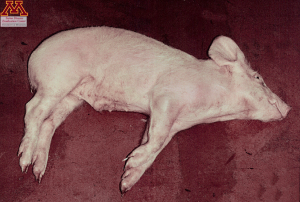Nervous and Locomotor Systems
Edema disease – F18 Escherichia coli
Clinical importance
Escherichia coli (E.coli) is the cause of various clinical presentations in all ages of pigs, ranging from diarrhea to urinary tract infection. This chapter focuses on the F18 strain, which typically effects post-weaning pigs around 10-12 weeks of age. F18 E. coli contrary to other strains is not characterized by diarrhea but by neurological signs. Economic losses can be important due to sudden deaths, causing between 50 and 90% mortality in nursery-age pigs.
Etiology and transmission
As a review, F18 E.coli is named by the type of antigen where F stands for Fimbrial, it is a STEC or a Shiga-Toxin producing E.coli. Nursery-age pigs are typically the most affected. Indeed, edema disease cannot be contracted by pigs less than 20 days of age because their enterocytes do not express the receptors to which F18 E.coli attaches, before then. Once in the body, E. coli proliferates within the jejunum and ileum in 3 to 6 days. The bacteria then releases the toxin that is absorbed by the intestine into the bloodstream. Shiga-toxins can cross the brain blood barrier and cause vascular damage, leading to vascular permeability and leakage of fluids in the brain tissue. Pigs typically come into contact with the bacteria through a contaminated environment or due to feco-oral transmission.
Which pigs are the most likely to present clinical signs associated with edema disease?
- Suckling piglets before their first week of life
- Suckling piglets after their first week of life
- Nursery-age pigs
Associated symptoms

Edema disease is characterized by a recognizable swelling of the eyelids and sometimes of the forehead. Affected pigs can also emit a high-pitched squeal due to the edema of the larynx. Pigs will show difficulty to walk or even stand up, progressively they will stay recumbent and display paddling. Mortality is high and usually affects heavy, good-looking pigs. Diarrhea and fever are very rare. In systemically infected pigs, signs consistent with septicemia, including rough hair coat and difficulty moving or eating are noticable.
Which of the following is NOT associated with F18 E.coli infection?
- Diarrhea
- Edema of the eyelids
- Paddling
Associated lesions
Macroscopic lesions
As the name suggests, Edema disease causes edema on forehead and eyelids but also in the intestinal tract. At necropsy, edema of the stomach mucosa and more commonly of the mesocolon can be observed. Mesenteric lymph nodes may be enlarged and edematous.
Microscopic lesions
The common microscopic lesion is degeneration of the arteries with edema of the surrounding tissues. Large number of bacteria can be seen attached to the jejunum and ileum of the pig.
Diagnosis
Symptoms and lesions are a good way to make a preliminary diagnosis. However, culture and isolation from intestinal tissue is easily done and the only way to definitively diagnose E. coli infection. A full set of tissues from untreated, acute cases should be sent to the diagnostic laboratory. The brain should not be forgotten, even though it is only the toxin that affects it.
Differential Diagnosis
A differential diagnosis for edema disease should include Streptococcus suis and Glaesserella parasuis as well as salt toxicity.
What is the best diagnostic test for edema disease?
- PCR test on brain tissue
- Culture on brain tissue
- Culture on intestinal tissue
- PCR test on affected joints
Treatment, Prevention and Control
During the early stages of infection, giving fluids to combat dehydration is the best option. Antibiotic treatment should be given intramuscularly for the most affected pigs that are expressing neurological signs but the prognosis is poor.
Penmates of the infected pig should be promptly treated with antibiotics, usually in the water, as they most likely are subacutely affected. A susceptibility test should be run but antibiotics that concentrate in the intestinal tract such as aminoglycosides should be preferred. However, the destruction of the bacteria releases a lot of toxins in the intestinal tract of the pig and can lead to aggravated signs but recovery.
Prevention of E. coli infection is entirely reliant on good management strategies. Once the bacteria has colonized the intestines, there is little the producer can do beyond antimicrobial therapy to prevent the disease from happening. During outbreaks, preventing the pigs from eating for 24h or so is said to limit the colonization of the intestine by F18 E.coli. Thoroughly cleaning and disinfecting all parts of the facility in between batches is critical because Edema disease tend to be recurrent in affected herds. Stress from inadequate environmental conditions such as stocking density and temperature should also be minimized. Vaccines with non-pathogenic Shiga-toxins have been shown to be effective in limiting the occurrence of clinical signs. Lastly, a lineage of pigs that are resistant to the disease because they do not express the F18 E.coli receptor, has been developed.

